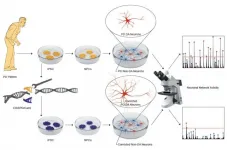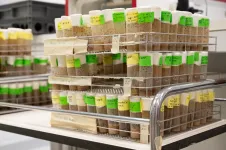Beyond 5G: Wireless communications may get a boost from ultra-short collimating metalens
2021-07-07
(Press-News.org) Screens may be larger on smartphones now, but nearly every other component is designed to be thinner, flatter and tinier than ever before. The engineering requires a shift from shapely, and bulky lenses to the development of miniaturized, two-dimensional metalenses. They might look better, but do they work better?
A team of Japan-based researchers says yes, thanks to a solution they published on July 7th in Applied Physics Express, a journal of the Japan Society of Applied Physics.
The researchers previously developed a low-reflection metasurface -- an ultra-thin interface that can manipulate electromagnetic waves -- specifically to control terahertz waves. These waves overlap millimeter waves and infrared waves, and, while they can transmit a significant amount of data, they easily attenuate in the atmosphere.
The technology may not be suitable for long-range wireless communications, but could improve short-range data exchanges, such as residential internet speeds, said paper author Takehito Suzuki, associate professor in the Institute of Engineering at Tokyo University of Agriculture and Technology. According to Suzuki, the researchers have taken a step toward such application developments by using their metasurface to craft the world's "top" ultra-short metalens that collimates to align an optical system with a distance of only one millimeter. The metalens is capable of increasing transmitted power by three at the far field, where the signal strength typically weakens.
"Terahertz flat optics based on our originally developed low-reflection metasurface with a high-refractive index can offer attractive two-dimensional optical components for the manipulation of terahertz waves," Suzuki said.
The challenge was whether the collimating lens, which converts approximately spherical-shaped terahertz waves to aligned terahertz waves, made with the metasurface, could be mounted closely to the electronics -- called a resonant tunneling diode -- that transmits terahertz waves at the right frequency and in the right direction. The minimal distance between the diode and the metalens is the necessary ingredient in current and future electronic devices, Suzuki said.
"We resolved this problem," Suzuki said. "We integrated a fabricated collimating metalens made with our original metasurface with a resonant tunneling diode at a distance of one millimeter." Measurements verify that the collimating metalens integrated with the resonant tunneling diode enhances the directivity to three times that of a single resonant tunneling diode.
The researchers tuned their device to 0.3 terahertz, a band at a higher frequency than the one used for 5G wireless communications. The manipulation of higher-frequency electromagnetic waves allows the upload and download of huge amounts of data in 6G wireless communications, according to Suzuki.
"The 0.3 terahertz band is a promising candidate for 6G offering advanced cyber-physical systems," Suzuki said. "And our presented collimating metalens can be simply integrated with various terahertz continuous-wave sources to accelerate the growth of emerging terahertz industry such as 6G wireless communications."
INFORMATION:
Suzuki is also affiliated with the Japan Science and Technology Agency. Other contributors include Kota Endo, Masashi Sekiya and Kento Sato, Department of Electrical and Electronics Engineering, Graduate School of Engineering, Tokyo University of Agriculture and Technology; and Jaeyoung Kim, ROHM Co.
For more information about the Suzuki laboratory, please visit http://web.tuat.ac.jp/~suzuki-lab/index-e.html, http://web.tuat.ac.jp/~suzuki-lab/index.html
Original Paper:
Resonant tunneling diode integrated with metalens for high-directivity terahertz waves
Kota Endo, Masashi Sekiya, Jaeyoung Kim, Kento Sato, and Takehito Suzuki
Applied Physics Express 14, 072002 (2021)
https://doi.org/10.35848/1882-0786/ac0678
Funding:
This research is supported by Grant-in-Aid for Scientific Research (C) (No. 18K04970) from the Japan Society for the Promotion of Science (JSPS), PRESTO from the Japan Science and Technology Agency (JST) (JPMJPR18I5), Inamori Foundation, Kato Foundation for Promotion of Science, Iketani Science and Technology Foundation, TEPCO Memorial Foundation, GMO Internet Foundation, and The Noguchi Institute.'
About Tokyo University of Agriculture and Technology (TUAT):
TUAT is a distinguished university in Japan dedicated to science and technology. TUAT focuses on agriculture and engineering that form the foundation of industry, and promotes education and research fields that incorporate them. Boasting a history of over 140 years since our founding in 1874, TUAT continues to boldly take on new challenges and steadily promote fields. With high ethics, TUAT fulfills social responsibility in the capacity of transmitting science and technology information towards the construction of a sustainable society where both human beings and nature can thrive in a symbiotic relationship. For more information, please visit http://www.tuat.ac.jp/en/.
Contact:
Takehito Suzuki, Ph.D.
Associate Professor,
Institute of Engineering,
Tokyo University of Agriculture and Technology, Japan
E-mail : takehito@go.tuat.ac.jp
[Attachments] See images for this press release:

ELSE PRESS RELEASES FROM THIS DATE:
2021-07-07
Researchers from IDIBELL and the University of Barcelona (UB) have described that neurons derived from Parkinson's patients show impairments in their transmission before neurodegeneration.
For this study, it has been used dopaminergic neurons differentiated from patient stem cells as a model.
Parkinson's is a neurodegenerative disease characterized by the death of dopaminergic neurons. This neuronal death leads to a series of motor manifestations characteristic of the disease, such as tremors, rigidity, slowness of movement, or postural instability. In most cases, the cause of the disease is unknown, however, mutations in the LRRK2 gene are responsible for 5% of cases.
Current therapies against Parkinson's are focus on alleviating the symptoms but do not stop its progression. It ...
2021-07-07
Scientists at the University of Southampton have discovered that changes in Earth's orbit may have allowed complex life to emerge and thrive during the most hostile climate episode the planet has ever experienced.
The researchers - working with colleagues in the Chinese Academy of Sciences, Curtin University, University of Hong Kong, and the University of Tübingen - studied a succession of rocks laid down when most of Earth's surface was covered in ice during a severe glaciation, dubbed 'Snowball Earth', that lasted over 50 million years. Their findings are published in the journal Nature Communications.
"One ...
2021-07-07
By combining two distinct approaches into an integrated workflow, Singapore University of Technology and Design (SUTD) researchers have developed a novel automated process for designing and fabricating customised soft robots. Their method, published in Advanced Materials Technologies, can be applied to other kinds of soft robots--allowing their mechanical properties to be tailored in an accessible manner.
Though robots are often depicted as stiff, metallic structures, an emerging class of pliable machines known as soft robots is rapidly gaining traction. ...
2021-07-07
Despite having been formalized as a species in 1936, Wolbachia pipientis remains an elusive microbe. The reason why relates to the relationship it establishes with its hosts. Wolbachia lives inside the cells of 40% of the arthropods, in their majority insects, intertwined in a symbiosis so complex that it can no longer survive on its own. "Guessing what it takes to grow and manipulate it outside the host might not be possible", says Luís Teixeira, IGC principal investigator. And, so far, despite countless attempts, no one has succeeded in culturing this bacterium or modifying its genetic sequence.
Before joining the team led by Luís Teixeira, Elves Duarte was interested in studying the symbiosis between ...
2021-07-07
East Hanover, NJ. July 7, 2021. A team of researchers identified nine meaningful reasons that prevent people with disabilities from seeking employment. Their findings provide a much-needed understanding of this population's motives for remaining unemployed, which can inform programs and policies that promote labor force participation of people with disabilities. The article, "Understanding Persons with Disabilities' Reasons for Not Seeking Employment" (doi: 10.1177/00343552211006773) was published in Rehabilitation Counseling Bulletin on April 15, 2021.
The authors are Denise C. Fyffe, PhD, Anthony H. Lequerica, PhD, and John O'Neill, PhD, of Kessler Foundation; Courtney Ward-Sutton, PhD, and Natalie F. Williams, PhD, of Langston University; and Vidya Sundar, OT, PhD, ...
2021-07-07
Palo Alto, CA--Dehydrated plant seeds can lay dormant for long periods--over 1,000 years in some species--before the availability of water can trigger germination. This protects the embryonic plant inside from a variety of environmental stresses until conditions are favorable for growth and survival. However, the mechanism by which the baby plant senses water and reactivates cellular activity has remained a mystery until now.
New work jointly led by Carnegie's Yanniv Dorone and Sue Rhee and Stanford University's Steven Boeynaems and Aaron Gitler discovered a protein that plays a critical "go, or no-go" role in this process--halting germination if the soil's hydrological conditions are ...
2021-07-07
The principle that form follows function does not only apply to design and architecture. It also applies to biology. Every organism is a universe that lives thanks to the activities of tens of thousands of nanomachines, whose functions depend on their forms. Biologists say macromolecular complexes instead of nanomachines and structure instead of form, but the idea is the same: know the form and you will understand the function. Now, a group at the Spanish National Cancer Research Centre (CNIO) has helped determine the structure of a nanomachine essential for the functioning of another, mTOR, which plays fundamental roles in ...
2021-07-07
A team led by researchers from Queen Mary University of London has developed a new artificial intelligence (AI) tool that is able to automatically measure the amount of fat around the heart from MRI scan images.
Using the new tool, the team was able to show that a larger amount of fat around the heart is associated with significantly greater odds of diabetes, independent of a person's age, sex, and body mass index.
The research is published in the journal Frontiers in Cardiovascular Medicine and is the result of funding from the CAP-AI programme, which is led by Barts Life Sciences, a research and innovation partnership between Queen Mary University of London and Barts Health NHS Trust.
The distribution of fat in the body can influence a person's ...
2021-07-07
Many people instinctively associate mucus with something disgusting, but in fact, it has incredibly many valuable functions for our health. It keeps track of our important intestinal flora and feeds the bacteria. It covers all internal surfaces of our body, and, as a barrier to the outside world, it helps us protect ourselves from infectious diseases.
This is because mucus acts as a filter that keeps the bacteria in or out, and the bacteria feed on the sugars in the mucus between meals. So, if we can produce the mucus that is already present in the body with the right sugars, it might be used in brand new medical treatments.
Now, researchers from the DNRF Centre ...
2021-07-07
Physicists of Ruhr-Universität Bochum (RUB) have taken spectacular pictures that allow the ignition process of plasma under water to be viewed and tracked in real time. Dr. Katharina Grosse has provided the first data sets with ultra-high temporal resolution, supporting a new hypothesis on the ignition of these plasmas: In the nanosecond range, there is not enough time to form a gas environment. Electrons generated by field effects lead to the propagation of the plasma. The nanosecond plasma ignites directly in the liquid, regardless of the polarity of the voltage. The report from the Collaborative Research Centre 1316 "Transient Atmospheric Pressure Plasmas: from Plasma to Liquids to Solids" has been published in the Journal of Applied Physics and Rubin, the ...
LAST 30 PRESS RELEASES:
[Press-News.org] Beyond 5G: Wireless communications may get a boost from ultra-short collimating metalens





